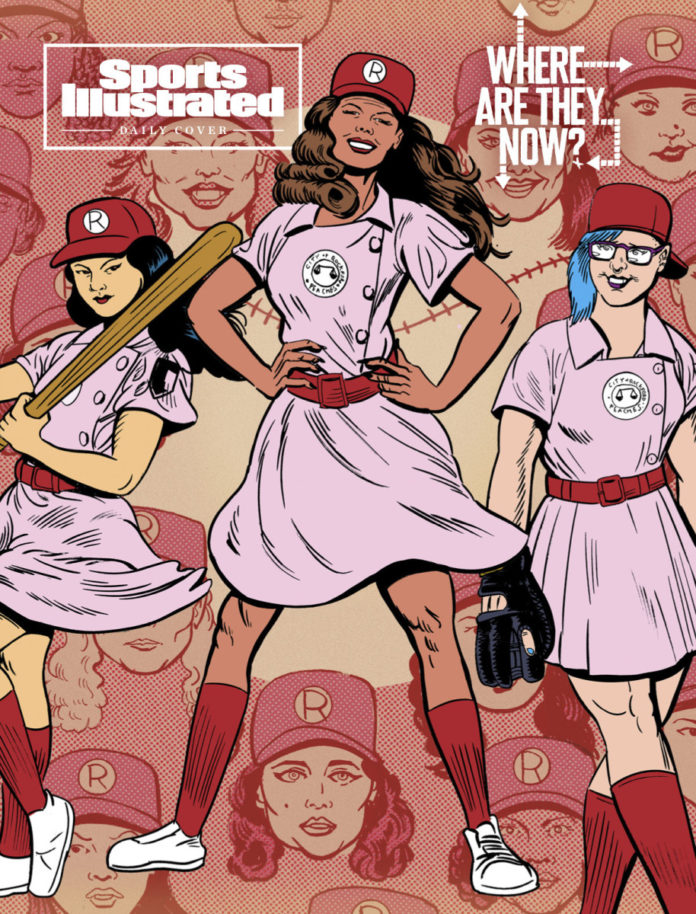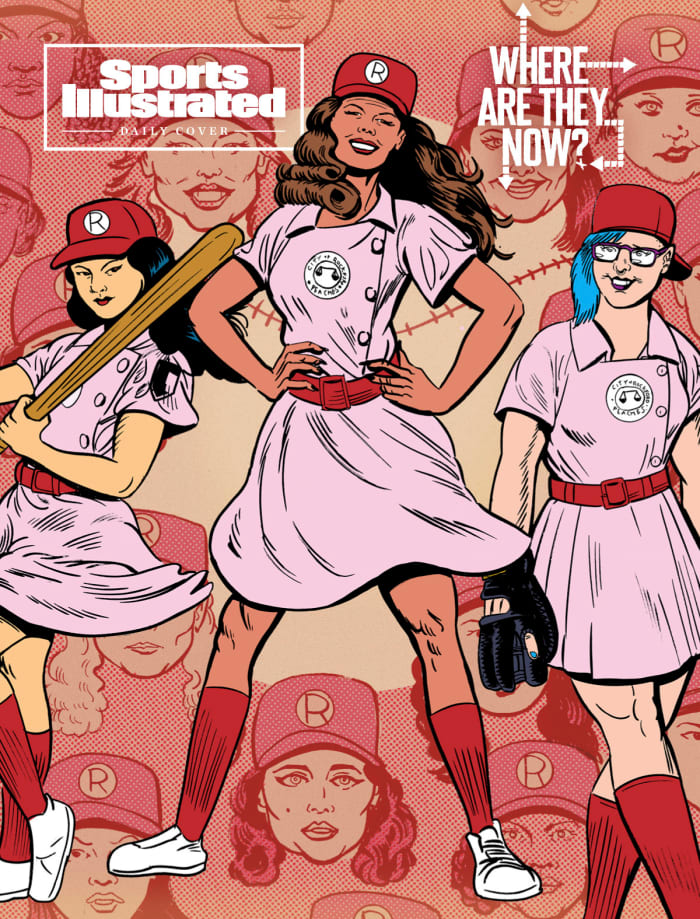Each summer Sports Illustrated revisits, remembers and rethinks some of the biggest names and most important stories of our sporting past. Come back all week for more WHERE ARE THEY NOW? stories.
The ballfield is modest. Still, it’s clear that it is cherished. The grass is cut short and the dirt kept neat, and the wooden benches in the dugouts are new, installed by the local Boy Scouts. There are bleachers that can sit a few hundred if they squeeze. Save for a handful of identifying details—one sign on the scoreboard, another over the old ticket booth, a collection of historical markers on the sidewalk—this might pass for any municipal field.
But people come to see it. They make the journey with all the reverence of a pilgrimage. They come to Rockford, Ill., to sit at Beyer Stadium and see a field that feels like history brought to life as much as it does like fantasy made real. This was home to the real-life Rockford Peaches in the All-American Girls Professional Baseball League from 1943 to ’54. This means, by extension, it is also home to the fictional Rockford Peaches from the film A League of Their Own, released in ’92. The movie did not use the park as a filming location, and while many of its characters were based on real women from the team and elsewhere in the league, none were exact representations of specific players. But there does not have to be a direct connection to be a spiritual one. This is still where people come to pay tribute to the movie. That makes two groups equally revered here—the women who once played real professional baseball and, decades later, the women who played them.
The film turns 30 this year. Its legacy is as strong as ever: It’s still the highest-grossing baseball movie of all time, and perhaps the most quotable, too. Next month, its source material will take on a new life, when A League of Their Own is reimagined as a streaming series on Prime Video. But for many, the original remains deeply, devoutly beloved.
On the first weekend in July—the anniversary of the movie’s premiere—Beyer Stadium filled with fans who had come to celebrate the occasion in Rockford. The group included some who have loved the movie since its original run in theaters and some who were born years after its release. They came from all over Illinois, across the Midwest and beyond. And I came from the East Coast to ask them why they made the trip.
They came because they love the cast, with its crackling, sparkling chemistry. (Geena Davis! Tom Hanks! Rosie O’Donnell and Madonna!) Because it’s so damn funny. Because even the minor characters are fleshed out with details that make them memorable. Because it’s a sports movie—a women’s sports movie—that’s really about sports, physical and intense and shown on screen, rather than squeezed in as an afterthought. Because of all its one-liners. Because its portrayal of sisterhood is pitch-perfect, expertly navigating the intense, fraught overlap between love and competition. Because there’s no crying in baseball. Because sometimes there is crying in baseball. Because, all these years later, there is still room to argue: Did Dottie really drop the ball on purpose? Because it’s a great movie about baseball, and a great movie about sisters, and a great movie, period.
This is part of why A League of Their Own became the hit it did in 1992 and part of why people still journey to the Peaches’ field in 2022. But our trip was about more than just the love of the film—there are plenty of movies we love that don’t compel us to make such a pilgrimage. For many of us, the film has a more personal significance. For the women of Rockford—for those who did not have to travel to get to Beyer Stadium in early July—A League of Their Own preserved a vital piece of history. It reminded some of them of a past they’d never wanted to forget and showed others a world they’d never had a chance to remember in the first place.
The Rockford Peaches in the movie were fictional. But the Rockford Peaches at Beyer Stadium were real, and as the film passes this landmark anniversary while the new series awaits its premiere, the material feels as resonant as ever.
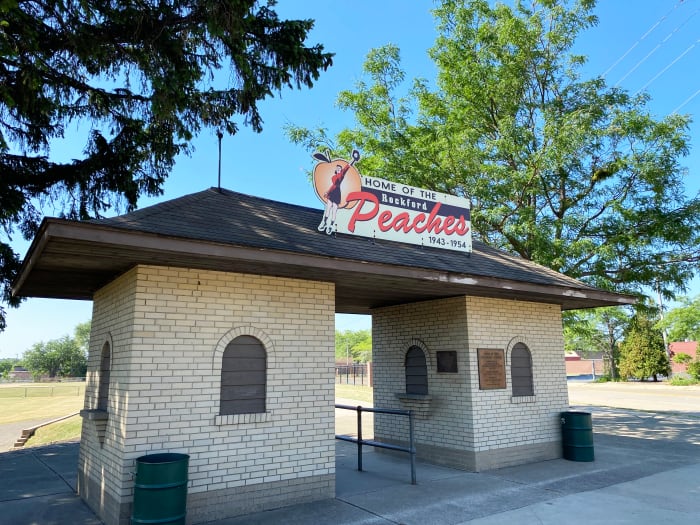
The ticket booth at Beyer Stadium, which was home to the real life Rockford Peaches of the AAGPBL.
Emma Baccellieri/Sports Illustrated
The history behind the film goes like this: The AAGPBL was the brainchild of chewing-gum magnate and baseball executive Philip Wrigley, who thought a league of women might be successful while the men’s player pool was depleted during World War II. The AAGPBL launched in 1943 and outlasted the war—peaking with 10 teams and attendance of more than 900,000 in ’48—before ultimately folding in ’54. (The Peaches and the South Bend Blue Sox were the only two teams to play in the league from start to finish.) For many of the players, and the girls who had a chance to watch them, women’s professional baseball had been life-changing. But there was little sign of it preserved in mainstream culture. As years turned into decades, there was even less, and the collective memory of the league began to fade.
Then came a 1987 documentary, also called A League of Their Own, produced by Kim Wilson and Kelly Candaele, whose mother had played in the AAGPBL. Film director Penny Marshall—an avid baseball fan who had previously never heard of the AAGPBL—saw the project and was captivated. She knew she had to make a movie about the league. For a focal point, she settled on the Rockford Peaches, the most successful team in the AAGPBL with four championships between ’45 and ’50. The rest was history: Marshall’s A League of Their Own may have been fictionalized, but it captured women’s professional baseball as a very real idea, and it opened a window to another world for many women who loved the game.
Which had a particular significance for women in Rockford—an enduring connection to the movie, and to the history of the Peaches, with parameters that shift along generational lines.
Read More Where Are They Now? Stories
Norma Smith, 84, grew up watching the Peaches. She idolized them. “Baseball was our life,” she says. “They were my heroes.” As a girl, this was the only professional baseball she saw. She dreamed of growing up to play for her hometown team as a Peach—the most ordinary of childhood dreams for a little boy, traditionally impossible for a little girl, yet as real as it possibly could have been for her. But the league folded midway through her time in high school. Smith’s beloved Peaches were gone, and as the decades passed, it seemed almost unbelievable they had existed in the first place. And then she saw them on screen, 40 years later, preserved more or less as she had remembered—in a way that could make a little girl dream again of playing for her hometown team.
Carol Keller, 62, was born after the Peaches folded. But her father had gone to their games (including a few that he claimed to have watched over the fence when he didn’t have enough spare quarters for a ticket) and told her when she was a child: There was a baseball team here, a team of women, playing just like the men. “Always, since then, I’ve been a Rockford Peaches fan,” she says. “Just from the stories.” To see A League of Their Own as an adult, then, was to see a possibility she had never considered: Here were her father’s stories brought to life. They were even better than she had imagined. Keller has since watched the movie “dozens of times”; she owns a replica uniform and doesn’t think she has ever gone a year without a rewatch. (Her favorite character is Marla Hooch … What a hitter!) Yet she still feels the same glimmer of joy with every viewing—for her town, for her father, for herself.
Scroll to Continue
SI Recommends
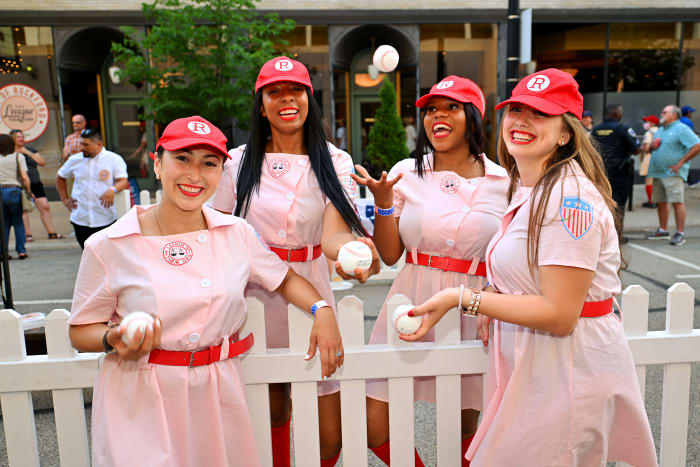
Fans of “A League of Their Own” attended the special screening of the new Prime Video series held in Rockford, Ill., wearing Rockford Peaches uniforms, on July 2, 2022.
Daniel Boczarski/Getty Images for Prime Video
Cathy Headley, an associate professor of kinesiology at Rockford University, is a little younger than Keller. But she did not grow up with stories of the Peaches or the AAGPBL—she had no idea they existed. She did grow up in love with baseball. “I played with the boys, because that was all I knew,” she says of her childhood in Streamwood, Ill., about an hour away from Rockford. A passionate Cubs fan, she’d learned to keep score from her father as a young girl, and she’d been hooked on the game ever since. She was in college when A League of Their Own came out. It felt like a revelation: All those years she had played as the only girl in her cul-de-sac—feeling as if she might be the only girl playing anywhere—and here was this history she had never known, so close to her hometown, of women just like her from decades ago.
There was one detail in particular that made Headley gasp with recognition. When manager Jimmy Dugan (Hanks) stops in the dugout to photograph an enormous bruise on Alice Gaspers (Renée Coleman), the moment works for a bit of a laugh. But Headley fixated on the bruise: They understand. The baseball in the movie looked real. It felt real. This was the way Headley had always played: tough, physical, intense. She’d once ripped her knee open so badly on a collision when she slid that she needed stitches. (Headley would later try out for the Colorado Silver Bullets, the women’s barnstorming team sponsored by Coors Light during the mid-1990s after the success of A League of Their Own.) It wasn’t just that this movie was showing women playing baseball. It was showing women playing baseball like her. It wasn’t sanitized or made nice and neat for Hollywood. In fact, though Headley didn’t know it while sitting in the theater, Coleman’s bruise had been real—not makeup!—because the action itself had been real. Here was a movie with an understanding not only that women could play but that bruises had to be part of the equation.
“You don’t connect to the history until you really see it,” Headley says. “It just felt like a blessing to be able to see.”
And behind Smith and Keller and Headley is 41-year-old Natasha Roberts. She had no particular connection to baseball when she first saw the movie years ago, but she loved it all the same, because of how it showed her hometown of Rockford, and because it was simply a great watch. Now, she has found another layer of significance: Her daughter, Annabelle, loves baseball. She turns nine this month, and she plays for the Lil Peaches, the all-girls youth team in town. Roberts showed her the movie for the first time this summer. As expected, Annabelle was enchanted. It didn’t matter that the movie came out long before she was born or that its story took place even longer before. It was special to her in a way that felt both historic and poignantly, deeply personal: It was girls playing baseball.
“She understands, you know, Mom’s already taught me I can do anything a boy can do,” Roberts says. “But this solidifies it—that it doesn’t matter that she’s a girl and that she can play.”
These women all came downtown to celebrate the film’s anniversary in early July. They love the movie as a movie—just as anyone might. But they love it as something more, too. A League of Their Own is a dream they never got to see come true; a story they never imagined they would see acted out; a reminder they were never, ever as alone as they felt; a gift to cherish and pass down. Its narrative and characters are fictional. But it’s a window to real stories and real women—and it’s this connection that means so much to the women of Rockford, stretching across generations and backgrounds and experiences, a historic tie that has not loosened.

The new “A League of Their Own” series is not a remake. It features different characters, pulling from different parts of the real history, who are engaged in different stories.
Courtesy of Prime Video
The people behind the new A League of Their Own on Prime went into the project with one thing certain: The movie did not need a remake.
Co-creators Abbi Jacobson (Broad City) and Will Graham (Mozart in the Jungle) had both loved the original since childhood. For Jacobson, who also stars in the show, the movie had resonated immediately. A sporty kid who loved softball and soccer, she had never seen anything that so accurately portrayed what it meant to be on a team of girls. “I just wasn’t clued in to anything that felt like a more equal representation of what I was doing as a kid.” For Graham, there was a connection to his own athletic experience, too: He played Little League but never felt like he fit. “I wouldn’t have been able to say I was gay at the time. But I felt like I was very different,” he says. “And for me, there was something in the movie that gave this beautiful sense of, you’re allowed to be on the field, even if you don’t think you’re supposed to be there.”
But years later, rewatching the film while staying in a hotel, Graham found himself curious about the real history of the AAGPBL. It felt like there was so much more to explore: other players, other teams, other scenarios. The movie had one particular moment that hinted at the wealth of women’s baseball stories from the period even beyond the AAGPBL: When a ball at a Peaches game rolls foul, a Black woman watching at the fence steps forward to pick it up, and she’s invited to gently toss it over. Instead, she stuns everyone by showing off a rocket of an arm. Then she nods, steps back and is never seen again. The scene lasts all of 15 seconds. But it evokes a whole world of baseball beyond what’s shown on screen—a reference to the fact that Black women were barred from the AAGPBL, yet they played baseball, too. Three women even broke the gender barrier in the Negro Leagues in the 1950s: Toni Stone, Connie Morgan and Mamie “Peanut” Johnson. There was a history rich in material here that had not been in the original film.
So in 2017, Graham approached Jacobson about the potential to reimagine A League of Their Own for television—not a straight remake, not engaging with the same beloved, impossible-to-imitate characters, but taking the setting and joyous spirit of the film and using it as the basis for a totally new project. “We immediately started talking about how the film didn’t need to be remade,” Jacobson says. “Instead it was, well, if we’re going to do this, it has to be really showcasing the stories that were not in the film.” The possibilities were invigorating. But the pair didn’t want to take them on without Marshall’s blessing.
They were able to meet with the director before she died in 2018. And they were pleasantly surprised by how she opened up the conversation: She told them her original cut of the movie was four and a half hours. She fully understood there was more material here—enough to fill a television series—because she had tried to use so much of it herself.
“There was so much that she had wanted to include and so many stories that she wanted to tell—including the stories of Black women who went on to play in the Negro Leagues—that she was glad there was going to be a chance that those stories might get told,” Graham says.
They soon dived into research. And in watching everything they could find, combing through archives and speaking to the remaining living players, they realized there was another vein of untold stories here—the LGBTQ women in the league. None of them had been out publicly in their playing days. But there had been several of them. (In 2020, Netflix released a documentary called A Secret Love about AAGPBL player Terry Donahue and her wife, Pat Henschel, who had been together since the ’40s but did not come out to their families until 2009.) The showrunners found these women and drew inspiration from them.
Some players who had never been out publicly decided to open up to the showrunners. It felt like too important a piece of their experience in the league to possibly omit. One, 95-year-old Maybelle Blair, who pitched for the Peoria Redwings in the 1940s and served as a consultant for the show, decided to come out for the first time when she was invited to speak on stage after the show’s premiere at the Tribeca Film Festival in June. “I think it’s a great opportunity for these young girl ball players to come to realize that they’re not alone and you don’t have to hide,” she said. “I hid for 75, 85 years.”
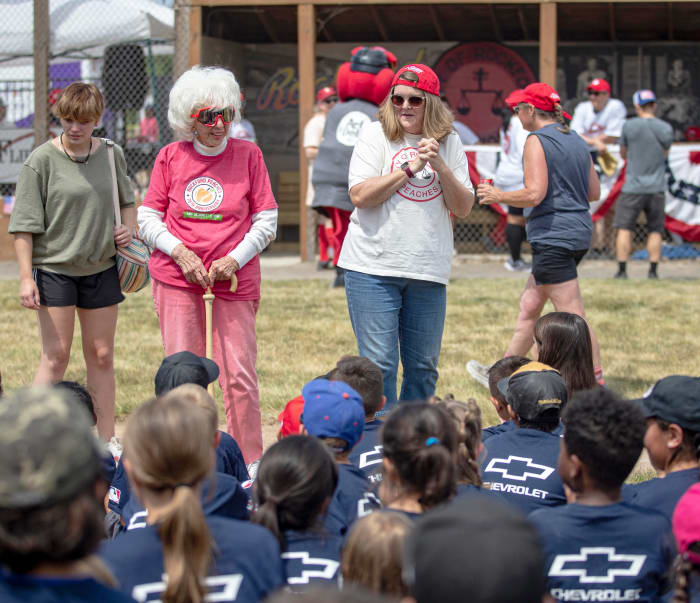
Blair and Megan Cavanagh, who played Marla Hooch in “A League of Their Own,” speak to kids on Saturday, July 2, 2022, at Beyer Stadium in Rockford.
Chris Nieves/Rockford Register Star/USA TODAY Sports Network
Even as the AAGPBL gave women an opportunity in pro ball that had not existed before or since, it was keen on a very conventional idea of femininity (hello, playing in skirts), and there were all sorts of dangers in navigating that scene as a closeted gay player. Yet it was Blair’s happiness that struck the showrunners: When they asked for her experience meeting other LGBTQ women in the league at the time, she told them, “It was a party.” That was the spirit they wanted to carry into the show.
“I’ve been asked about incorporating those stories, but it’s like—that is the story,” says executive producer Desta Tedros Reff. “It is the real story.”
There were Black women who wanted to play in the AAGPBL and could not. There were gay women who knew they could not risk being outed. Marshall’s film included a few nods to these ideas. But now—in the real estate of a series, rather than a two-hour movie, three decades later—those stories are explored more on screen.
“Just telling a sports story about women was revolutionary,” Tedros Reff says of the original film. “But there was so much more underneath the surface, and that just wasn’t a time with the ability to tell those stories, and that’s our opportunity.”
When the series begins streaming on Aug. 12, it might feel familiar in that it centers on the Rockford Peaches in 1943. But these are different characters, pulling from different parts of the real history, engaged in different stories.

The new “A League of Their Own” series explores the stories of Black women who could not play in the AAGPBL.
Courtesy of Prime Video
Yet there are pieces of the show that are still very much tied to the spirit of the original. One is the baseball itself. It was just as important to Jacobson and Graham as it had been to Marshall to make sure the game felt true to life. That meant studying how an MLB game is shot to learn how to replicate the experience—how to capture as many angles of each play as possible with limited camera equipment. It also meant bringing on a head baseball consultant, Justine Siegal, the first woman to throw MLB batting practice and to coach for an MLB organization. The cast prepared through weeks of training camp. For more intense scenes, to make sure the action was just right, they used doubles—real-life women players.
They’re part of the legacy of the original film, too. For many of them, there are few visible examples of women on the field in the modern game, and there’s certainly nothing like the AAGPBL. But there’s always been A League of Their Own.
Siegal runs a girls baseball organization called Baseball for All; every year, when the group holds its national tournament, she sees the continued impact of the movie. The girls are as young as 10. But almost every single one who comes to play, year in and year out, knows the words to the song from the film: “We’re the members of the All-American League / We come from cities near and far.” Some of the women who worked as doubles for the new series started out playing in Siegal’s tournaments when they were little girls. To play baseball on screen like this was a dream—to be part of a new version of the movie that had inspired some of them to keep playing while standing in for the very women who had shown what it meant to play in the first place.
“I can’t say enough how important it was,” Siegal says. “I mean, to honor the AAGPBL as well as to honor the legacy of the movie—that was at the forefront of everybody’s mind.”
The result is on-screen baseball that aims to feel every bit as real and as physical as that of the original. It’s one of several threads that the showrunners hope to carry through from the film—and another one, perhaps the most important, is its sense of joy. The original took itself plenty seriously. It’s a wartime story, after all, and it’s textured with conflict and tragedy. But so much of what makes it special is the happiness that shines through all the same: Marshall’s vision of what it means to love baseball and one another and the simple opportunity to be on the field. It’s a huge part of what has made the film endure the way it has. The showrunners hope that it shines through in their version, too.
“It was this idea of telling this story that really has joy at the center—yes, you have to overcome some obstacles,” Graham says. “But you get to do the thing you want to do.”
Nearly four decades passed between the collapse of the AAGPBL and the original release of A League of Their Own. In that time, Beyer Stadium fell into disrepair. After being used for other local sports for some time, its decaying stands were eventually torn down, and the field became overgrown. Of the actual, physical infrastructure that existed for the Peaches, all that remains is a ticket booth, still welcoming passersby at the corner of 15th Avenue and Seminary Street.
There was never a serious move to demolish the stadium entirely. There was only the long, slow process of forgetting. The movie reversed that. Now, it’s not just remembered but actively preserved, with some parts that have been restored and others that have been entirely built new. There is an ongoing fundraising effort to establish a women’s baseball center nearby. The site is historic, but there is now something a bit timeless about it, too: It feels lived-in. This is where real women played the game, and it’s where a cast of fictional women brought them back to life, and it’s where girls can finally play again today.
The ballpark’s significance is rooted in the past. But it does not feel like a relic. It feels—crucially and beautifully—like a baseball field.
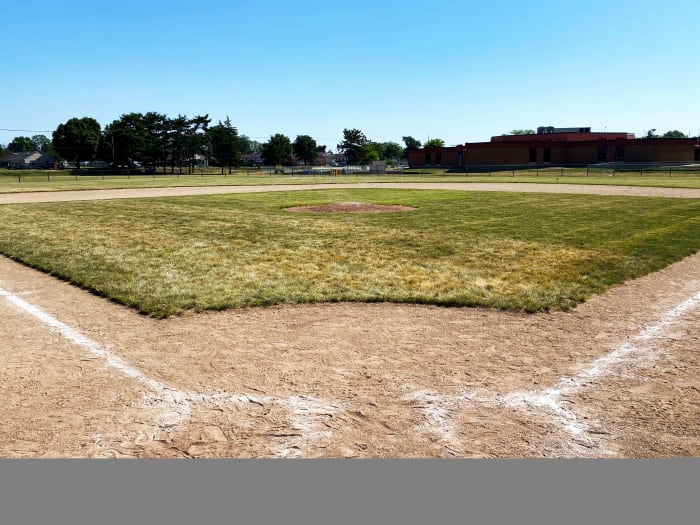
People come to Beyer Stadium to pay tribute to the real Rockford Peaches of the AAGPBL and the fictional team that represented them in “A League of Their Own.”
Emma Baccellieri/Sports Illustrated
On the first Saturday in July, for the anniversary festivities, that ballpark had been filled with fans. On Sunday, it was empty. I walked through the old ticket booth, down the third-base line, over to the dugout.
I had spent days, at this point, asking people about what the movie meant to them—first at the Tribeca Film Festival premiere of the new show in New York City and now in Rockford. And there was something that had surprised me: Almost all of the women I talked to then turned the question back on me. “So why do you love A League of Their Own?” It was simply assumed that I did—that this story had not just been assigned at random. In a different context, I might have prickled at this, at the idea that the woman baseball writer had gone out of her way to write about the women’s baseball movie. But the assumption was correct: I do love A League of Their Own in a way I love no other baseball movies, few other movies at all, because how could I not? I always had. To be a woman in baseball—to be a woman who loves baseball at all—is to realize you do not really have a choice in whether the film means something to you. It simply does.
I hadn’t even tried to give that answer the first few times I was asked the question: I hadn’t even known, really, it was my answer. By the end of Saturday night, I had a clumsy, reaching version of it. And on Sunday morning, I left the dugout at Beyer Stadium and walked out to home plate, and I stood there for a long, long time.
Stream A League of Their Own with fuboTV: Start a trial today.
Read More Where Are They Now? Stories:
• Cinderella, After the Ball: Life at Saint Peter’s Already Looks Much Different
• The Goalie From ‘Mighty Ducks’ Lost Everything. The Internet Saved Him.
• John Amaechi: ‘You Want Gay People to Come Out? Make It So It’s Not S—-y’
• Steffi Graf Is Still Too Famous For Steffi Graf
• The GOAT Abides: Gary Smith, the Sportswriter in Repose

